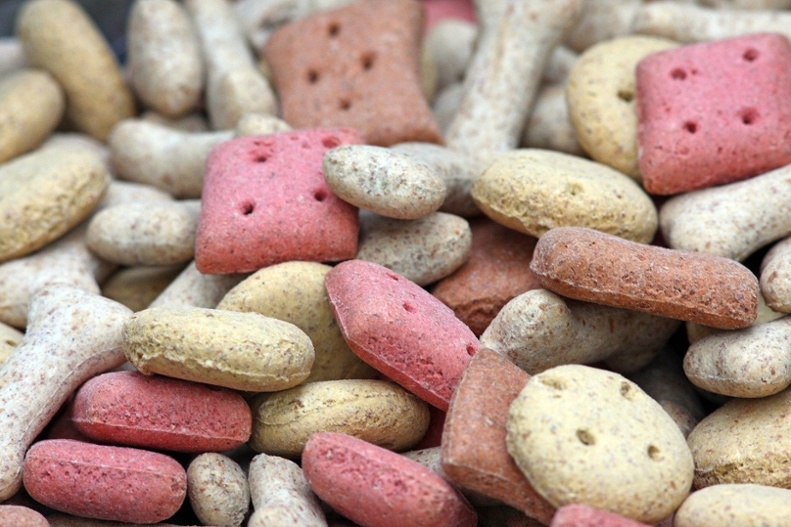Owners have always given their pets treats. Traditionally, these were human foods – scraps dropped onto the floor at mealtimes, bones buried in gardens and strings of sausages stolen from butchers’ shops, at least in cartoons. I once saw a border collie wolf down an entire kilogram of Cheddar cheese that had been thrown out of a window during a drunken party – perhaps that was more gastrointestinal breeze block than treat, though -- I don’t know what happened to the dog afterwards.
Dog biscuits in various shapes and colours have been around for a long time, as have specially formulated chocolate drops that don’t contain theobromine, which is poisonous to dogs. But in recent times, commercial treats for cats and dogs have become increasingly popular.
Pet treat sales
A review by Euromonitor showed that between 2009 and 2014, pet treats were among the top five hottest growth categories in every global region, including Asia, Eastern Europe, Latin America, Middle East/Africa, North America and Western Europe. In the UK, during 2014, it was estimated that around 87% of owners give their pets treats. Even cats have been getting in on the action; although the total numbers of treats bought for cats has traditionally been much lower than that for dogs, sales are increasing. In the US, the percentage of cat-owning households purchasing pet treats grew from 39.6% in 2006 to 52.8% in 2013. This is still lower than the figure for dogs, which was 81.6% in 2013, undergoing only a modest increase from 79.1% in 2006. In Canada, on the other hand, the percentage of dog and cat owners purchasing treats for their pets is similar, at 79 and 74%, respectively.
Types of pet treats available
If pets could do their own shopping, they’d probably be delighted at the variety of treats on offer. A glance at the website of a major UK supermarket reveals 126 different items in the section entitled “dog treats and biscuits” and 51 products listed under “cat treats and milk”.
Dog treats on offer include traditional dog biscuits, crunchy and chewy snacks with a meaty theme, pure meat products, including jerky, pig ears, roast lamb bones and tripe sticks, and items with no meat content at all – the specially formulated chocolate drops mentioned above come into this category. Cats, on the other hand, can choose from a range of products with a poultry or fish theme, including snacks with a crunchy outside and a soft centre and a selection of specially formulated milks with a low lactose content. There seems to have been some confusion recently in the UK about the origins of cat milks. One supermarket has felt the need to put up a sign stating that they don’t actually come from lactating cats.
Pet treats are made from various combinations of meat or meat-derived materials with other ingredients, such as potato starch, vegetables, fruits, cereal flours, fats, oils and additives, whereas jerky products consist mainly of dried and flavoured or pure meat or animal by products, such as pig skin. Techniques used in their preparation include extrusion, baking and freeze drying.
Marketing of pet treats
Although many treats are described as tasty, most are not marketed simply on the basis of the pleasure they may provide, but in terms of the added vitamins and minerals they contain and the health benefits they offer. Some dog treats, for instance claim to improve joint flexibility and dental health and others are described as vegetarian, hypoallergenic, gluten-free and suitable for diabetic dogs, whereas cat treats may offer the promise of a healthy coat or freedom from hairballs. Low fat varieties are available for the overweight pet and products of different sizes can be purchased for small, medium and large dogs.
Of course, pet treat marketing is not aimed directly at the dog or cat, but at its owner. Much of the information on offer clearly taps into the humanization trend, the tendency of people to regard their pets as quasi-human members of the family. Some products even have names resembling those of human foods and sound quite tempting. I would place “doggie doughnuts” and “cheesy muffins” in this category. Doggie birthday cakes, cup cakes and cookies are also available on the internet, together with recipes for making your own treats, including a particularly delicious sounding salmon and oatcake cookie recipe for cats. Many pet treats are also described as “pure” or “natural” or, increasingly, “grain free”.
Safety concerns
Since 2007, the US Food and Drug Administration has been receiving reports of illness in pets associated with the consumption of jerky treats. By the end of September 2014, approximately 5000 reports of pet illness had been reported, including more than 1000 canine deaths. Most of the symptoms included gastrointestinal and liver disease and about 30% were linked to kidney and liver failure. Reportedly, most cases of illness occurred after the pets had eaten chicken, duck or sweet potato jerky treats imported from China. Samples of some Chinese chicken jerky products were found to contain the antiviral drug, amantadine, but this is not thought to be responsible for the effects seen in pets. However, many pet treat companies in the US no longer source products or ingredients from China. In addition, in 2015, some beef jerky treats manufactured in the US tested positive for Salmonella and were recalled.
Obesity
Feline and canine obesity is a significant health concern. In 2013, according to the Association of Pet Obesity Prevention (APOP), 57.6% of US cats and 52.6% of US dogs were overweight or obese, and in 2014 obesity levels remained at epidemic proportions. Veterinarians reported that 93 and 88% of owners of obese dogs and cats, respectively, initially believed their pets to be in the normal weight range, a disparity in awareness known as the “fat gap”. The UK People’s Dispensary for Sick Animals (PDSA) estimates that of the UK’s 18 million pets, over 2 million cats (one in four) and 2.5 million dogs (one in three) are overweight.
The APOP claims that the additional calories in many pet treats are a major factor in the rise in obesity, and the PDSA has stated that in the long term, owners are killing their pets with kindness by giving them treats. They advise that dogs should only be given treats as rewards during training and that ideally, the treats should be low calorie, e.g. carrots. They concede that if the dog doesn’t like low calorie foods, small amounts of foods with a higher calorie content can be used, but the dog’s overall food intake must be adjusted accordingly. The PDSA also says that cats don’t need treats at all, because most cat foods already provide all the required nutrients, but that if owners can’t resist treating their cats occasionally, they should give them small pieces of lean meat and again reduce the amount of food in their main meals so that their overall intake remains the same.
Cannabis and pet treats
Hemp-based supplements and treats are now being used by pet treat marketers to provide category extension and a point of difference. Many recipes for their preparation using industrial hemp seeds, hemp seed oil and other ingredients, such as cannabis-infused butter, are also available on the internet. Hemp seeds are described as a superfood, both for humans and pets, because they contain a beneficial ratio of omega 3 to omega 6 fatty acids and are a good source of easily digestible protein and dietary fibre.
There is a certain amount of controversy about this in the US. Commercial producers of hemp-based pet treats are popping up all over the place. Some companies claim that their products provide a range of general health benefits, and that their cannabinoid content, which mainly consists of compounds such as cannabidiol and only trace amounts of the psychoactive tetrahydrocannabidiol (THC) has negligible impact - pets consuming their treats do not experience a high and the only potential side effect is mild sedation. Many pet owners, however, are not giving their pets hemp-based supplements or treats because of their general nutritional benefits, but because they feel that they offer pain and anxiety management for sick and distressed animals. Some vets in the US are concerned; they fear that scientific evidence for the benefits of hemp products is lagging behind sales. It also appears that some companies are preparing pet treats by infusing basic ingredients with THC and may be rushing to sell potentially illegal cannabis-containing pet products before the law catches up with them.
Of course, cats have their own special mood enhancing plant. Catnip (Nepeta cataria), traditionally used as a stuffing for cat toys, is a natural herb that contains the bicyclic terpenoid, nepetalactone. Inhalation of nepetalactone can give cats what is described as a “playful high”, but can make them aggressive in large quantities. Susceptibility to nepetalactone is controlled by genes, and studies suggest that 20% of cats are unaffected by it.
So why do people give their pets treats?
Training
The use of treats as a training aid for dogs is a practice that predates the rise in dog obesity by a considerable number of years. Perhaps, such dogs tend to be relatively active and burn off the extra calories. Although cats are less easy to motivate, some experts claim that treats can be used to encourage feline companions to spend time with their owners rather than disappear through the catflap to an unknown destination at the least opportunity and to teach them to use the litter tray rather than next door’s flowerbed.
Happiness
The PDSA Animal Wellbeing (PAW) report found that owners enjoy giving their pets treats. 39% of owners say it makes them feel caring, whereas 49% say it makes them feel happy. Only 3% of owners mention negative emotions, such as guilt and 66% think the treats make their pet happy.
Perhaps, the 66% are right; after all treats make humans happy, and pets have the added advantage that - presumably anyway - they don’t suffer from guilt after consuming an unhealthily high number of calories. And surely it isn’t beyond the bounds of possibility that users of cannabis in the US states where it has been legalized may see hemp and other cannabis products as a simple treat for their healthy pets in the same way as for themselves?
Related Posts:
- Dogs' Dinners and Cats' Cuisine
- Is Ritual Slaughter a Problem for Meat Eaters?
- How Do You Make a Healthier Product?
Image by Denise coyle from Pixabay


